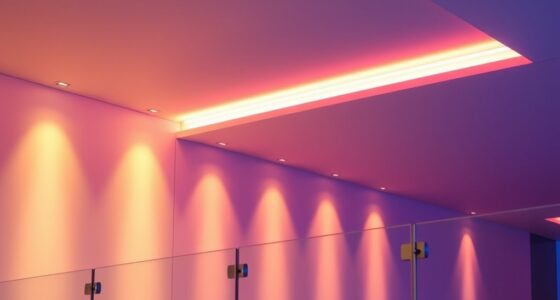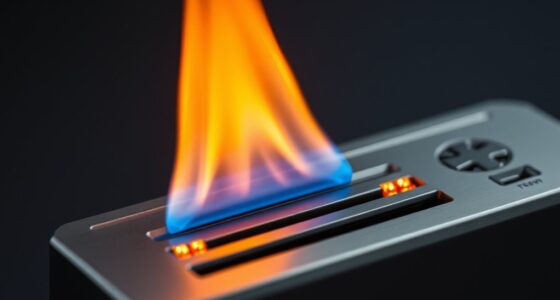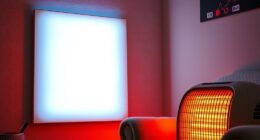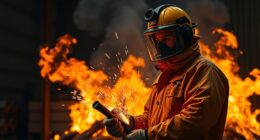Before starting realistic flame effects, you should double-check all ignition system components for proper operation and compatibility, ensuring wiring and igniters are in good shape. Verify fuel safety, storage, and compatibility, and follow strict handling procedures. Establish clear safety protocols, wear protective gear, and keep fire extinguishers nearby. Organize your workspace, ground all equipment, and conduct thorough tests to confirm reliability. Continuing will give you detailed steps to prepare confidently and safely for your flame effects.
Key Takeaways
- Verify all ignition system components are compatible, in good condition, and thoroughly tested for reliable operation.
- Confirm fuel types and handling procedures align with ignition system specifications for safety and effectiveness.
- Establish and follow safety protocols, including protective gear, clear work area, and emergency preparedness.
- Ensure proper grounding, organized workspace, and secure connections to prevent accidental discharges or hazards.
- Conduct controlled tests to verify ignition reliability, record results, and perform regular maintenance of ignition equipment.
Pre-Start Checklist for Flame Effects Safety
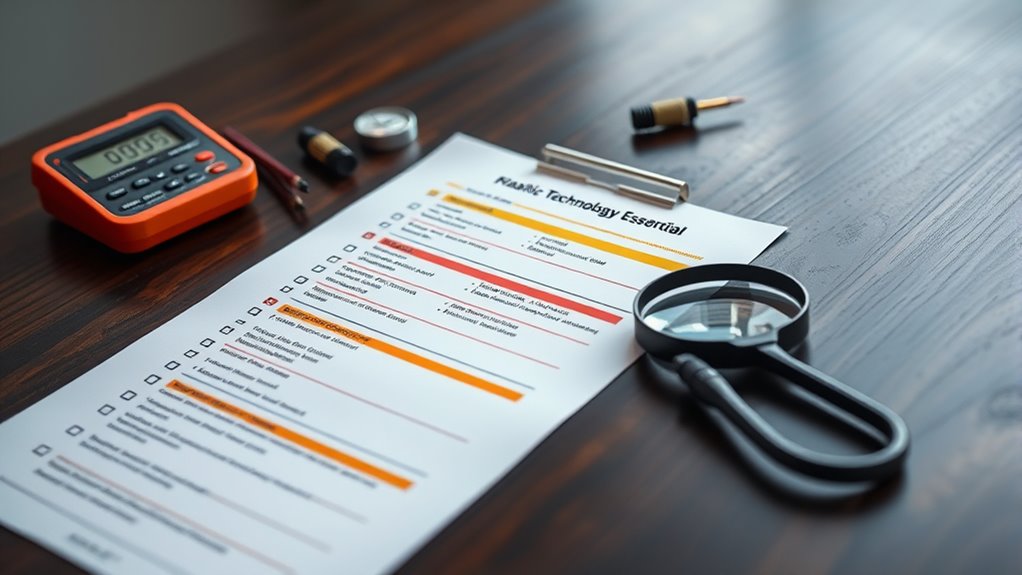
Creating realistic flame effects requires attention to detail and a solid understanding of the basic techniques involved. Before diving into designing or operating any flame simulation or pyrotechnic setup, you need to guarantee that your ignition systems are properly configured and reliable. Ignition systems are the heart of your flame effects, responsible for igniting fuel sources safely and efficiently. Check that all components, from igniters to wiring, are in good condition and compatible with your setup. Faulty wiring or incompatible igniters can lead to misfires or dangerous malfunctions, so testing your ignition system thoroughly before starting is essential. You should also verify that your ignition controls are functioning correctly, allowing you to operate the flames remotely or manually with precise control.
Equally important are your safety protocols. Establish clear procedures for handling fuels, igniters, and other equipment involved in creating flame effects. Always wear appropriate protective gear—gloves, goggles, and fire-resistant clothing—to minimize risk. Make sure your work area is cleared of unnecessary personnel and that fire extinguishers or suppression systems are within easy reach. Familiarize yourself with emergency procedures in case something goes wrong, such as an unexpected flare-up or equipment malfunction. When working with ignition systems, double-check all connections before powering up to prevent accidental ignitions or shorts. Never bypass safety features or attempt to modify ignition controls; doing so can compromise safety and lead to uncontrolled fires.
Additionally, it’s essential to keep your setup organized and free of clutter to avoid accidental discharges or trips. Proper grounding of your ignition system reduces static buildup, which could otherwise cause unintended ignitions. Understand the characteristics of the fuels you’re using—whether gas, liquid, or solid—and guarantee your ignition system is compatible with each type. Always test your ignition system in a controlled environment to confirm it ignites reliably and consistently, which is fundamental for realistic flame effects. Record your test results, noting any inconsistencies or issues so you can troubleshoot effectively. Furthermore, understanding vetted products and safety-rated equipment ensures you work with reliable tools designed for flame effects.
Frequently Asked Questions
What Are Common Signs of Faulty Flame Effect Equipment?
You’ll notice faulty flame effect equipment if the ignition system struggles to light the flames or if they flicker irregularly. Watch for weak or inconsistent flames, which could indicate sensor calibration issues. Unusual noises or delays in flame detection also signal problems. Regularly inspect the ignition system and sensor calibration to guarantee proper operation, preventing further damage and maintaining a realistic, safe flame display.
How Often Should Flame Effects Safety Inspections Be Performed?
You should perform flame effects safety inspections at least every six months to guarantee proper equipment maintenance and safety protocols. Regular inspections help identify potential issues early, preventing accidents or damage. During these checks, verify all components are functioning correctly, clean any debris, and test safety features. Staying consistent with these inspections keeps your flame effects safe, reliable, and compliant with industry standards.
What Emergency Procedures Are Recommended During a Flame Effect Malfunction?
If a flame effect malfunctions, you must act instantly like a superhero! Immediately activate fire suppression systems and shout emergency communication alerts to everyone nearby. Evacuate the area if needed, and keep a fire extinguisher handy. Never attempt to fix the issue yourself—wait for trained professionals. Remember, quick, decisive actions can prevent disaster, protect lives, and keep everyone safe during a flame effect emergency.
Are There Specific Safety Certifications Required for Flame Effect Operators?
Yes, as a flame effect operator, you need specific safety certifications to guarantee safe operation. These certifications demonstrate you meet the operator requirements for handling flammable materials and equipment safely. You should complete recognized safety training programs, such as OSHA or fire safety courses, and obtain any specialized flame effect certifications required by local regulations or your employer. Staying certified helps you operate responsibly and minimizes risks during performances.
How Do Weather Conditions Impact Outdoor Flame Effect Safety?
Weather conditions substantially impact outdoor flame effect safety. High winds can cause flames to spread unpredictably, increasing fire risk, while rain or humidity may affect equipment operation or cause electrical hazards. You should always assess weather impact before ignition, postponing or adjusting effects as needed. Incorporate safety considerations by securing equipment against wind, using weather-resistant materials, and monitoring weather updates regularly to prevent accidents and ensure safe operation.
Conclusion
Before firing up your flame effects, always run through your safety checklist to prevent accidents. Remember, nearly 60% of fire-related incidents are caused by overlooked safety steps. Staying vigilant and prepared can make all the difference in ensuring a safe, spectacular display. Keep your focus sharp, double-check your equipment, and enjoy the fiery show without worry. Safety isn’t just a step—it’s the foundation for a successful and memorable event.


